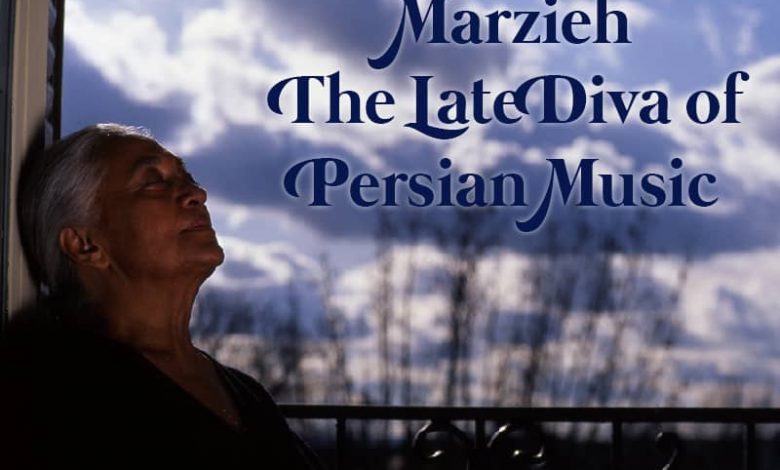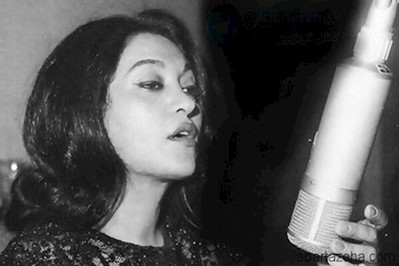Iran: Marzieh, Great Diva of Persian Traditional Song and Voice of Freedom and Resistance

Written by
Mohammad Sadat Khansari
On October 12, 2012, at the height of autumn’s cold, Iran lost its warmest voice. Marzieh, the great diva of Iranian songs, became eternal. Now on the anniversary of the passing of this great national artist and the brave freedom-fighter, we take a glance at her life.
Ashraf-ol Sadat Mortezaei, with the stage name of Marizeh, started her career at the age of 19. In 1943, three years after Iran’s national radio establishment, Marzieh was among the first artists to perform on radio.
One of Marzieh’s first works of art was participating in the most valuable music program of Radio Iran called “Golhay-e Rangarang,” or “Colorful Flowers”. Marzieh’s competence in the art of combing poetry and music, and singing over 2,000 songs, turned her into Iran’s legendary singer.

But what shines beyond Marzieh’s artistic values is the outstanding human character of this great woman and her brave patriotism that makes her unique as the lady of Iranian art.
When the mullahs’ regime took power in 1979, Marzieh stopped singing for 15 years. But Marzieh’s 15-year silence was the calm before the storm. Her love for Iran and Iranians caused her to join the movement for freedom and democracy. Her choice to be in the resistance’s ranks turned her into an eternal shining star in Iran’s history of art and culture.
The position of art and artists in the religious dictatorship of Iran
Since the mullahs’ regime hijacked the 1979, Iranian art and culture was among the first to be targeted by this medieval regime. Thus, Iranian artists in all fields of art came under fire by the mullahs’ regime.
Among all the Iranian arts and artists, music and musicians were the first and foremost victims of the reactionary clerics. Iranian musicians, singers, and Persian instrument players were subjected to the most severe anti-human and anti-cultural repressions of the mullahs. Many of them were forced to leave their homeland, and many were silenced forever or imprisoned and harassed by the regime.
Contrary to the mullahs’ regime and its hysterical opposition to arts, particularly music, the Iranian Resistance, particularly the People’s Mojahedin Organization of Iran (PMOI/MEK) paid enormous respect to the Iranian arts and artists.
The Iranian Resistance, despite being under sever oppression, has always considered preserving the Iranian culture and art as part of its struggle for freedom and democracy.
Thus, many Iranian artists and musicians joined the Iranian Resistance or became members of the National Council of Resistance of Iran (NCRI). Some of these renowned artists include Emad Ram, Master of Music, composer and singerl; Manouchehr Sakhaei, a popular Iranian singer; Ms. Marjan, renowned film actress, and singer; Bahram Alivandi, a prominent painter; Andranik Asatourian, renowned composer, songwriter, and singer; and Mansour Ghadarkhah, a director; and many other artists.
Meeting with Maryam Rajavi

After 15 years of silence, and living under pressure in Iran, in August 1994, Marizeh left Iran for Paris, where she met the NCRI’s president-elect Mrs. Maryam Rajavi and joined the Iranian Resistance. From that day until her last moments, Marzieh supported the MEK and Mrs. Rajavi with all her power and performed various concerts all over the world.
From 1993 until her voice became eternal, her life record is a valuable collection that makes Marzieh a unique phenomenon not only in the history of Iranian art, but also in the history of contemporary nations. She was among the rare great artists that combined art with the struggle for freedom. She put all her art in the path of her nation’s glorious resistance against the darkest dictatorship in Iran’s contemporary history. Her presence in Iraq, among the freedom fighters of the National Liberation Army, her concerts in different countries and her political activities and meetings with politicians helped the Iranian people’s struggle to move forward on the path of achieving freedom.
Marzieh, the diva of Iranian songs, was the pleasant voice of a nation’s 60 years of suffering and emotions. She represented Iranian women’s resilience and resistance in the face of the misogynous mullahs’ regime. Thus, her voice became eternal in Iran and its history.
When Marzieh joined the Iranian Resistance, she went to Camp Ashraf, home to the MEK and NLA members and held her first concert for them.
After entering Ashraf, her voice captured the hearts of the oppressed people in Iran and free Iranians around the world who had not heard her voice for 15 years.

She said: “I proudly wore a uniform of the struggle for freedom. I stand by my people until my last breath, proud and happy.”
In one of her letters she said: “I have not come for an easy victory. I have come to share in all the sorrows and joys and defeats and victories of the purest and bravest men and women of my nation.”
“I have come to use all my talent, power, energy, art, and voice for the freedom of the country, for the freedom of Iran and our honorable and noble people. I have come to warmly shake the hand of the great lady of the Iranian Resistance… I will be with you, with you in you, I will find spring,” she said.
Thus, Marzieh sang the dazzling and fiery song in the field of political struggle, which is was the song of honor and pride.
From “Kaveh Mihan” and “Iran Zamin” to “Like a Jungle” and “Freedom Army” and the call to prayer that is adorned with greetings to Fatemeh Zahra, Marzieh sang “in the name of the red rose,” encouraging all the walkers of “the midnight” of Iran under the mullahs’ regime to spread perfume of “the beloved” across Iran.
Having put all her art on the path of resistance against the darkest dictatorship of contemporary history, her life record became a valuable collection of art and resistance from the day she joined the resistance movement until her voice became eternal. Thus, she became unique not only in the history of Iranian art, but also in the art history of contemporary nations.


